Souls Growing Skywards with the Trees
At Pana, the cave graves were easy to find, half of them broken open, looming out of a granite slab in the oncoming dusk and framed by dark bamboo.
The baby graves? Well, as the beautiful kids who gave us directions and made us sign the guestbook said, they were in a “big tree”.
“These holes in the trunk,” I wondered to Z. But they seemed so natural, gnarled by age into natural knots.
So, no, we decided. They must be the bundles high up in the branches with the ferns shooting out of them, basket coffins transformed into a proliferation of life. 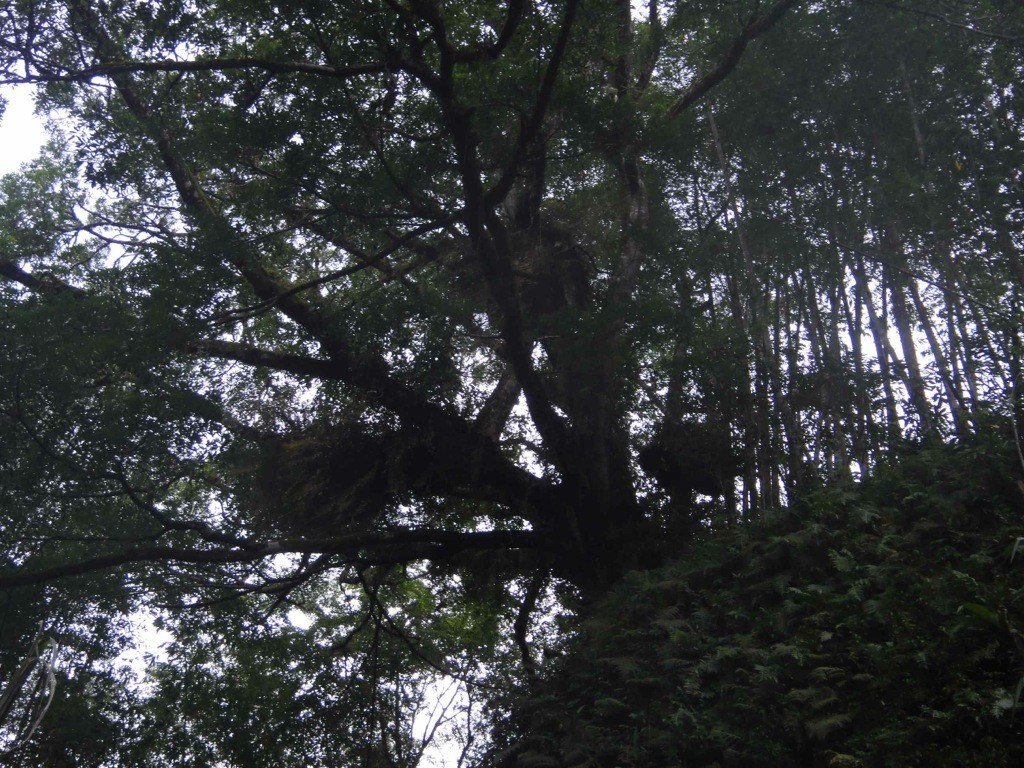
Since attending a traditional funeral the other day, I’ve been talking to a lot of Torajans about what they believe.
These are beautiful, friendly people, happy, sunny souls. They cut grass daily and feed it to their buffalo by hand simply to slaughter them at funerals. They work their entire lives to provide living gifts for sacrifice at their funerals and those of their infinitely extended family.
Joseph, a chap in his 40s, was my victim this evening. I bought him a beer in our local eatery and asked why the baby graves were in trees, not caves.
“In the old beliefs,” he says (though it’s hard to find a Torajan who doesn’t, when you talk to them properly, follow the old beliefs), “Spirits only go to Puya, the afterlife, when there is a buffalo sacrifice. But you can’t sacrifice a buffalo for a baby whose teeth have not come through. They go to somewhere different. Up into the sky.”
“So were they the bundles in the branches of the trees?” I ask.
Part of me is wondering how a mother can submit her tiny baby’s body to the branches of a tree, open to the sky, without the holocausts or ritual that must ease the pain of grief, then watch the leaves grow through the decaying body of an infant, their life cut short decades ahead of time.
“People who follow the old beliefs put the baby’s body in a living tree,” he says. “They wrap it in a blanket — no coffin — or areca bark. They cut a hole in the tree, only the size of the body. Then they put the baby’s body in it, and close it with palm leaves. Then as the tree grows to the sky, the babies go with it. Because they cannot go to Puya, they do not have souls, they carry on living. And, still living, they play in the sky like angels.”
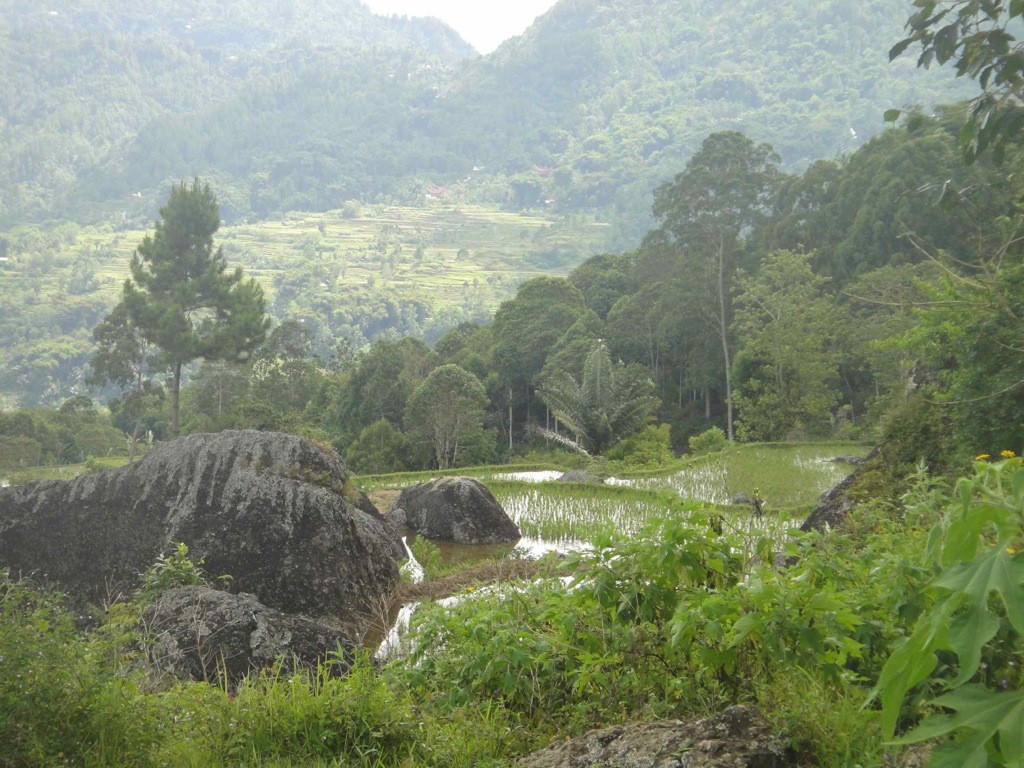
This culture is so foreign to me. And I have never lost a child. But I can see how this belief makes sense. It’s like a kinder version of the Limbo to which unbaptised babies went (go?) in Christian eschatology. They don’t die, because they don’t have a soul.
So you let them live with a living thing until they reach the sky. Almost as one might plant a fruit tree over the body of a loved one, and eat the fruit in remembrance.
It’s like the halfway house they have here, between death and life. When a person dies, their body stays in the family home, not dead, just sick, until the funeral is prepared, which is generally many months and sometimes years.
“Does it help?” I asked Arras, the night before, of this belief. “Did it help you when your father died?’
“Yes,” he said. He’s a Christian. And an animist. A very reflective man. “It helped.”
“But,” I say. “Surely you must have had that [I mime clenching grief] feeling, when your father died.”
“Yes,” he says. “I have that. Oh, I have that. But then I think. He is not dead. He’s sick. He’s sleeping. He’s still with me.”
“And that helped?” I ask.
“Yes,” he says. “It helped a lot.”
It was the open graves today that bothered Z. Not the opened cave graves.
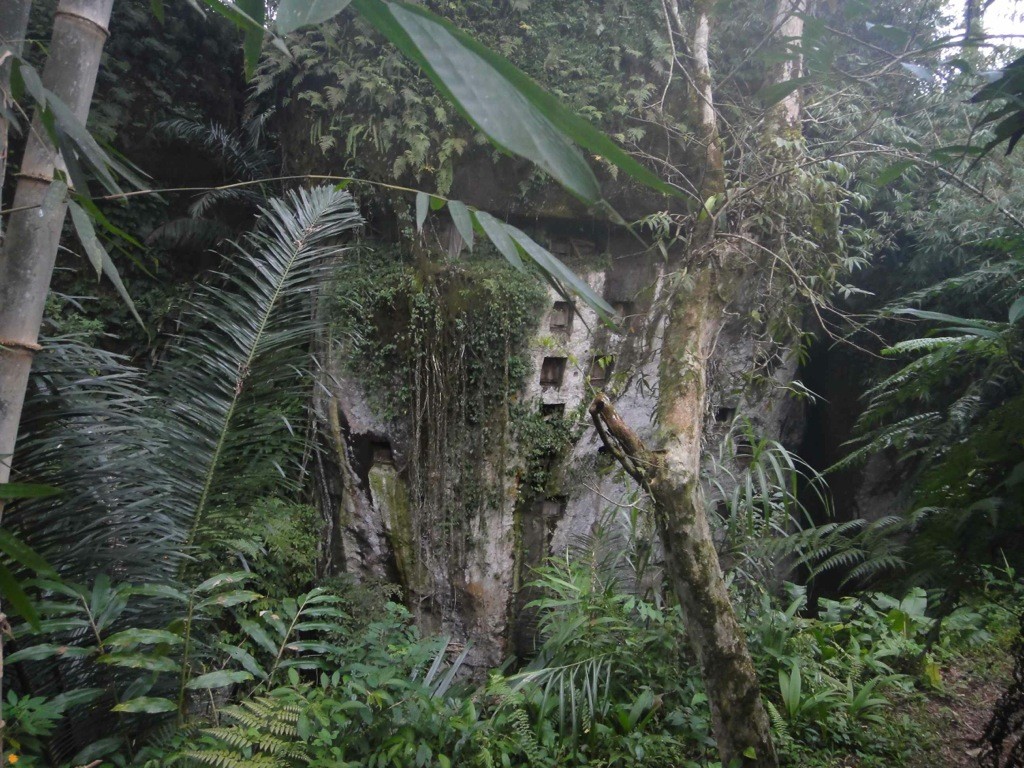
Now, they bothered me.
I don’t think of myself as superstitious (though, clearly, I am). But I wouldn’t have wanted to walk that road in the dark. Squeezing between the granite slabs in the lowering gloom to the rattan-fringed ravine over which the graves lowered was, well, unnerving, though the spirit of the place is kind.
It was the broken house graves we saw at Lokomata earlier that worried my son. “How can they let that happen to them?” he asked. “They’re just broken! How can they go to all that effort with the funerals, murder all those buffalo, then just let the graves fall to pieces like that?!”
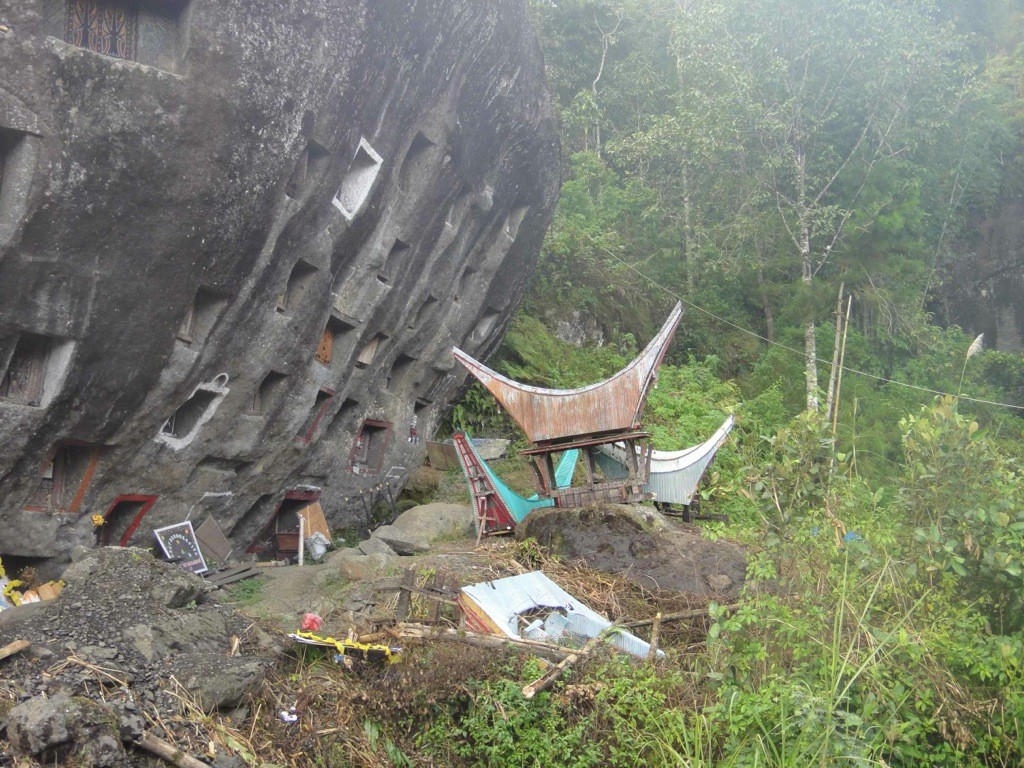
He asks Joseph the same question.
Well, says Joseph, in essence. That’s because the family have moved the body somewhere else. You know, as you do. With a grave burial, or a cave burial, you dig up the body and move them somewhere else. When you move your village, you know.
I don’t really know that. We hardly ever exhume in our culture. We are, in fact, very, very squeamish about our dead. We don’t touch them. Don’t lay them out. They stay with the doctors, the nurses, morticians, funeral directors…
It’s fairly rare for a body to rest in the house even on the night before the funeral, and exhumation generally only happens in the context of a criminal investigation. I’ve never seen a dead body. My parents have only seen their parents’ bodies.
Later, Z is helping a pretty teenager with her English homework, and Joseph and I are talking about Laos, and how animists there make offerings on new paths through the forest when they open them up. Torajans, he says, do that too.
I explain what we learnt walking the forests there, how most Lao believe that the spirits of people who are unburied haunt the forest, needing to feed. I tell him about the Lanahan people, who hold a gate-locking ritual every new year to protect their villages from the hungry spirits.
“Yes,” he says. “We have a ritual like that. If a person leaves the village and does not return, we take a blanket up onto the hill. We fasten one side, wait until it is filled with the wind, then close the blanket around the wind. We return to the village. And we hold a funeral for the blanket. One night, only.”
“You sacrifice a buffalo?” I ask.
“Of course,” he says. “Just one.”
“And do you believe in bad spirits?” I ask.
“Yes,” he says. “When something goes wrong in your life. When you are sick. You feel wrong. When things are going wrong. You go to the holy man, and he reads the bamboo. And he will tell you which of your ancestors are angry, and what they need.”
“So,” I say. “Those many broken house graves, those open cave tombs. They are angry ancestors, who needed to be moved.”
“Yes,” he says.
It was a paradoxical day today. A walk through a landscape dominated by death and packed with joy and life. Beautiful children calling out, walking on stilts, hanging with Z.
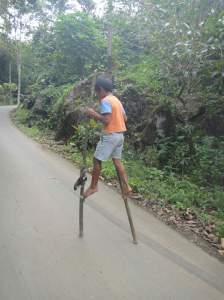
A constant hello from every house we passed. Young rice sprouting from the mirrored fields. Livestock lorries packed with guys and girls in funeral black, grinning, waving, taking our picture, cheery greetings from men carrying bamboos full of pig’s blood or the innards of a slaughtered buffalo.
And in the morning we went to Rantepao’s market, the animal fest which happens every six days, and chokes the streets with traffic. There was a buffalo there, albino and blue-eyed, with gold-coloured horns.
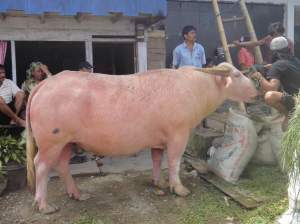
He was worth around $30,000. US. (Need a comparison? You can build an elaborate tongkonan house, complete with carvings and paintings, that will endure for generations, for $20,000, US.)
I showed his picture to folk we met along the road, as they chatted about the funerals coming up. They were, I think, impressed.

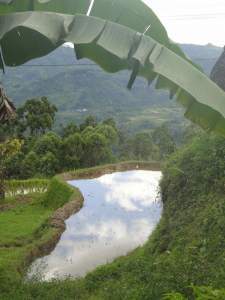
Wierder and wierder.
What beautiful beliefs. The symbolism of infants growing towards the sky as the tree grows is lovely, so different and yet so similar to the common western custom that you pointed out of planting a tree in the memory of someone lost. Placing infants in the trees sounds like such a quiet, peaceful practice – such a stark contrast to the funeral and sacrifices you told of the other day. Do you know if its something a mother or family does alone? Or does the whole village take part?
Beautifully told, thank you for sharing.
Wonderful story. It never amazes me, to what end people will expend energy and resources in the name of religion. I’m in Afghanistan now and folks pray 5 times daily, each prayer taking about a 1/2 hour. I think, “What I could do with an extra 2 1/2 hours each day,” to which a colleague replied, “And think of what the Talliban could do with an extra 2 1/2 hours each day.” I thought about it and said, “Good point.”
Beautiful story. Thank you for sharing it:)
Are you planning to hit Kelimutu in Flores?
Hi, haven’t seen a post from you in awhile…everything okay?
Ditto to Nicole’s comment. Hope all is well and you’re just having way too much fun to worry about a blog?
Oh…and great post, really interesting and unusual.
Hello all! We are fine and dandy. Just, I was told there was internet in the Togeans, and, lo and behold, there was only mobile reception if you stood in one guy’s bedroom at a certain time of the evening and they had the splitter on…
With the result that there was a very sudden silence.
Togeans were wonderful, btw, but I think Derawan is better…